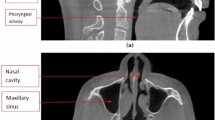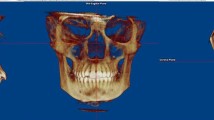Abstract
Objective To segment and measure the upper airway using cone-beam computed tomography (CBCT). This information may be useful as an imaging biomarker in the diagnostic assessment of patients with obstructive sleep apnea and in the planning of any necessary therapy.
Methods With Institutional Review Board Approval, anonymous CBCT datasets from subjects who had been imaged for a variety of conditions unrelated to the airway were evaluated. DICOM images were available. A segmentation algorithm was developed to separate the bounded upper airway and measurements were performed manually to determine the smallest cross-sectional area and the anteriorposterior distance of the retropalatal space (RP-SCA and RP-AP, respectively) and retroglossal space (RG-SCA and RG-AP, respectively). A segmentation algorithm was developed to separate the bounded upper airway and it was applied to determine RP-AP, RG-AP, the smallest transaxial-sectional area (TSCA) and largest sagittal view airway area (LCSA). A second algorithm was created to evaluate the airway volume within this bounded upper airway.
Results Measurements of the airway segmented automatically by the developed algorithm agreed with those obtained using manual segmentation. The corresponding volumes showed only very small differences considered clinically insignificant.
Conclusion Automatic segmentation of the airway imaged using CBCT is feasible and this method can be used to evaluate airway cross-section and volume comparable to measurements extracted using manual segmentation.
Similar content being viewed by others
References
Bradley TD, Phillipson EA (2002) Sleep disorders. In: Murray JF, Nadel JA (eds) Textbook of respiratory medicine, 3rd edn, vol 2. Saunders, Philadelphia, pp 2153–2169
Rivlin J, Hoffstein V, Kalbfleisch J (1984) Upper airway morphology in patients with idiopathic obstructive sleep apnea. Am Rev Respir Dis 129:355–360
Shellock FG, Schatz CJ, Julien P, Steinburg F, Foo TK, Hopp M, Westbrook PR (1992) Occlusion and narrowing of the pharyngeal airway in obstructive sleep apnea: evaluation by ultrafast spoiled GRASS MR imaging. Am J Roentgenol 158:1019–1024
Galvin JR, Rooholamini SA, Stanford W (1989) Obstructive sleep apnea: diagnosis with ultrafast CT. Radiology 171:775–778
White J, Cates C, Wright J (2001) Continuous positive airways pressure for obstructive sleep apnoea. Cochrane Database Syst Rev (4):CD001106
Lim J, Lasserson TJ, Fleetham J, Wright J (2004) Oral appliances for obstructive sleep apnoea. Cochrane Database Syst Rev (4):CD004435
Bridgman SA, Dunn KM, Ducharme F (1998) Surgery for obstructive sleep apnoea. Cochrane Database Syst Rev (1):CD001004
Jamieson A, Guilleminault C, Partinen M, Quera-Salva MA (1986) Obstructive sleep apneic patients have craniomandibular abnormalities. Sleep 9:469–477
deBerry-Borowiecki B, Kukwa A, Blanks RH (1988) Cephalometric analysis for diagnosis and treatment of obstructive sleep apnea. Laryngoscope 98:226–234
Partinen M, Guilleminault C, Quera-Salva MA, Jamieson A (1988) Obstructive sleep apnea and cephalometric roentgenograms. The role of anatomic upper airway abnormalities in the definition of abnormal breathing during sleep. Chest 93:1199–1205
Lyberg T, Krogstad O, Djupesland G (1989) Cephalometric analysis in patients with obstructive sleep apnoea syndrome: II. Soft tissue morphology. J Laryngol Otol 103:293–297
Rachmiel A, Aizenbud D, Pillar G, Srouji S, Peled M (2005) Bilateral mandibular distraction for patients with compromised airway analyzed by three-dimensional CT. Int J Oral Maxillofac Surg 34:9–18
Lam B, Ooi CG, Peh WC, Lauder I, Tsang KW, Lam WK, Ip MS (2004) Computed tomographic evaluation of the role of craniofacial and upper airway morphology in obstructive sleep apnea in Chinese. Respir Med 98:301–307
Li HY, Chen NH, Wang CR, Shu YH, Wang PC (2003) Use of 3-dimensional computed tomography scan to evaluate upper airway patency for patients undergoing sleep-disordered breathing surgery. Otolaryngol Head Neck Surg 129:336–342
Chen NH, Li KK, Li SY, Wong CR, Chuang ML, Hwang CC, Wu YK (2002) Airway assessment by volumetric computed tomography in snorers and subjects with obstructive sleep apnea in a Far-East Asian population (in Chinese). Laryngoscope 112:721–726
Kawamata A, Fujishita M, Ariji Y, Ariji E (2000) Three-dimensional computed tomographic evaluation of morphologic airway changes after mandibular setback osteotomy for prognathism. Oral Surg Oral Med Oral Pathol Oral Radiol Endod 89:278–287
Morovic CG, Monasterio L (2000) Distraction osteogenesis for obstructive apneas in patients with congenital craniofacial malformations. Plast Reconstr Surg 105:2324–2330
Bhattacharyya N, Blake SP, Fried MP (2000) Assessment of the airway in obstructive sleep apnea syndrome with 3-dimensional airway computed tomography. Otolaryngol Head Neck Surg 123:444–449
Ogawa T, Enciso R, Memon A, Mah JK, Clark GT (2005) Evaluation of 3D airway imaging of obstructive sleep apnea with cone-beam computed tomography. Stud Health Technol Inf 111:365–368
Hilgers ML, Scarfe WC, Scheetz JP, Farman AG (2005) Accuracy of linear temporomandibular joint measurements with cone beam computed tomography and digital cephalometric radiography. Am J Orthod Dentofacial Orthop 128:803–811
Author information
Authors and Affiliations
Corresponding author
Rights and permissions
About this article
Cite this article
Shi, H., Scarfe, W.C. & Farman, A.G. Upper airway segmentation and dimensions estimation from cone-beam CT image datasets. Int J CARS 1, 177–186 (2006). https://doi.org/10.1007/s11548-006-0050-8
Published:
Issue Date:
DOI: https://doi.org/10.1007/s11548-006-0050-8




